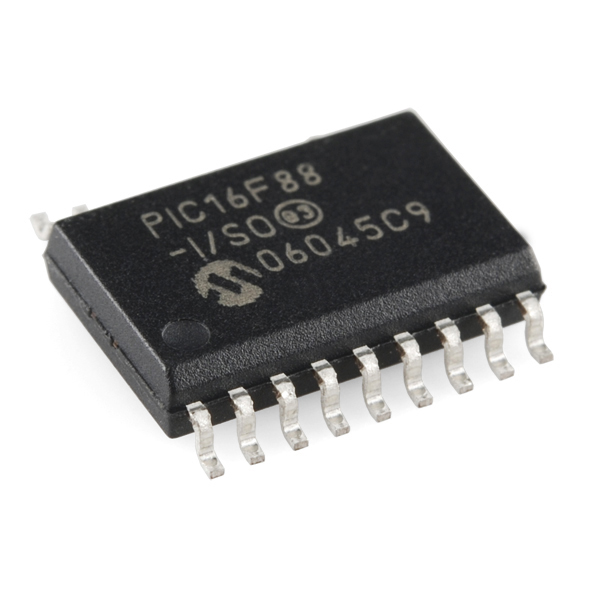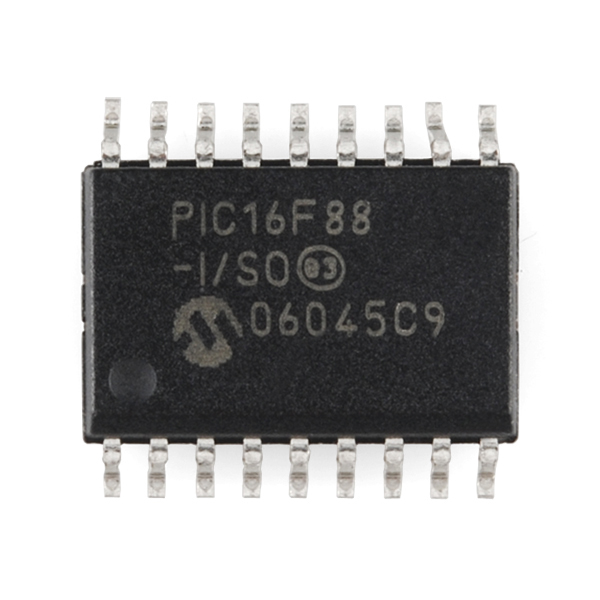PIC 18 Pin 8MHz - PIC16F88-I/SO
Replacement: None. We are no longer carrying this PIC in our catalog. This page is for reference only.
This powerful (200 nanosecond instruction execution) yet easy–to-program (only 35 single word instructions) CMOS Flash-based 8-bit microcontroller packs Microchip’s powerful PIC® architecture into an 18-pin package and is upwards compatible with the PIC16C7x, PIC16C62xA, PIC16C5X and PIC12CXXX devices. The PIC16F88 features 8 MHz internal oscillator, 256 bytes of EEPROM data memory, a capture/compare/PWM, an Addressable USART, a synchronous serial port that can be configured as either 3-wire Serial Peripheral Interface (SPI™) or the 2-wire Inter-Integrated Circuit (I²C™) bus, 7 channels of 10-bit Analog-to-Digital (A/D) converter and 2 Comparators that make it ideal for advantage analog / integrated level applications in automotive, industrial, appliances and consumer applications.
Note: These are production stock that we no longer use in any assembly so we've decided to sell them here. Once we run out of stock, these are gone for good, so get 'em while you can!
- 1 PWM 10-bit
- 8 MHz Internal Oscillator
- ICD
- 256 bytes of EEPROM data memory
- Capture/Compare
PIC 18 Pin 8MHz - PIC16F88-I/SO Product Help and Resources
Core Skill: Soldering
This skill defines how difficult the soldering is on a particular product. It might be a couple simple solder joints, or require special reflow tools.
Skill Level: Competent - You will encounter surface mount components and basic SMD soldering techniques are required.
See all skill levels
Core Skill: Programming
If a board needs code or communicates somehow, you're going to need to know how to program or interface with it. The programming skill is all about communication and code.
Skill Level: Competent - The toolchain for programming is a bit more complex and will examples may not be explicitly provided for you. You will be required to have a fundamental knowledge of programming and be required to provide your own code. You may need to modify existing libraries or code to work with your specific hardware. Sensor and hardware interfaces will be SPI or I2C.
See all skill levels
Core Skill: Electrical Prototyping
If it requires power, you need to know how much, what all the pins do, and how to hook it up. You may need to reference datasheets, schematics, and know the ins and outs of electronics.
Skill Level: Competent - You will be required to reference a datasheet or schematic to know how to use a component. Your knowledge of a datasheet will only require basic features like power requirements, pinouts, or communications type. Also, you may need a power supply that?s greater than 12V or more than 1A worth of current.
See all skill levels
Comments
Looking for answers to technical questions?
We welcome your comments and suggestions below. However, if you are looking for solutions to technical questions please see our Technical Assistance page.
Customer Reviews
No reviews yet.




Do you sell a progammer for smd PICs?
Usually what you'll do for SMD PICs is to solder the unprogrammed chip to your PCB, and then connect your PCB to the programmer with a six-pin ICSP (In-Circuit Serial Programming) cable. All of our programmers have headers for such a cable.
thanks Mike!